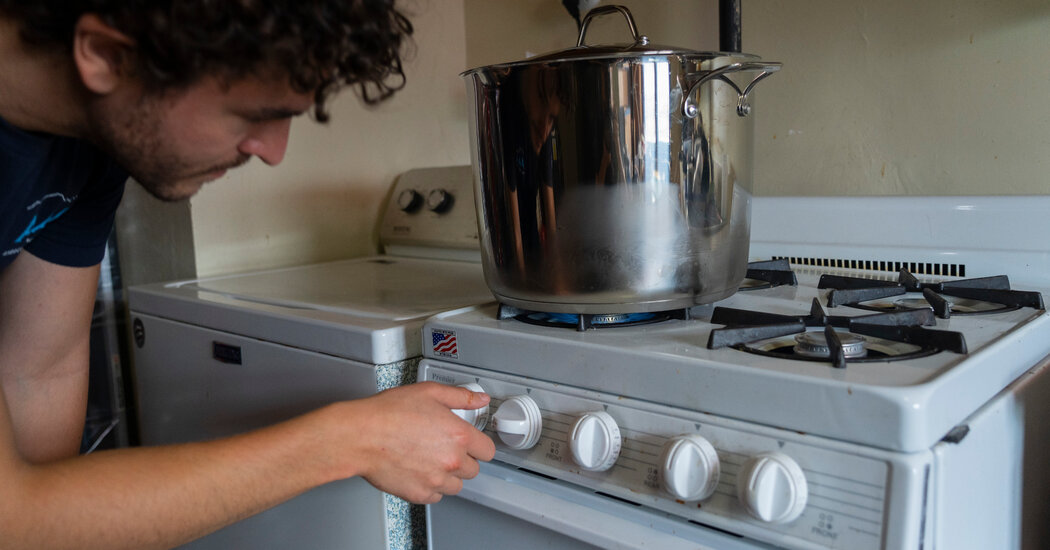For decades, scientists have worked to clean up air pollution from factories, cars and power plants. But researchers are increasingly turning their attention to the air that people breathe indoors. And one appliance has come to the fore as a source of pollutants harmful to human health: the humble gas stove.
A new study from researchers at Stanford University sheds light on how much Americans may be exposed, indoors, to nitrogen dioxide, which comes from burning coal and gas and has been linked to asthma and other respiratory conditions.
The researchers found that, across the country, short-term nitrogen dioxide exposure from typical gas stove use frequently exceeded benchmarks set by both the World Health Organization and the United States Environmental Protection Agency. In the longer term, using gas or propane stoves meant that the typical American could breathe in three-quarters of the nitrogen dioxide levels deemed safe by the W.H.O. within their own homes.
As with outdoor pollution, disadvantaged households may be more exposed, the researchers found. Because gas more easily spreads throughout smaller spaces, people in homes smaller than 800 square feet were exposed to four times more nitrogen dioxide in the long term than people in homes larger than 3,000 square feet, the study found. Black and Latino households were exposed to 20 percent more nitrogen dioxide compared with the national average.
“We’ve done a really good job in this country of reducing outdoor pollution,” said Rob Jackson, professor of earth system science at the Stanford Doerr School of Sustainability and a principal investigator on the study, which was published on Friday in Science Advances. “But we’ve ignored the risks that people face indoors. And that’s the air that we’re breathing most of the time.”
And though home cooks who use a gas stove are particularly exposed to nitrogen dioxide, he said, “we’re getting a better handle on the migration of pollution down the hall, to the living room and the bedroom.”
The focus on gas stoves isn’t without critics. When a Biden administration official spoke about the health hazards of gas stoves last year, Republican politicians and their allies accused the administration of overreach and of planning to ban gas stoves outright.
Next week, House Republicans are set to meet on a bill called the Hands Off Our Home Appliances Act, which would make it harder for the Department of Energy to set more stringent energy-efficiency standards on household appliances, including gas stoves.
Health experts say that the health risks posed by gas stoves are significant. “There really is no safe amount of exposure to these toxicants produced by gas or propane, or any fossil fuel, outside or inside,” said Kari Nadeau, chairwoman of the Department of Environmental Health at the Harvard T.H. Chan School of Public Health.
The Stanford study estimated that long-term exposure to nitrogen dioxide from stoves was likely causing up to 50,000 cases of asthma in children.
Some cities and counties have tried to move away from gas altogether, as part of a transition to cleaner forms of energy. Over the past few years, more than 140 cities and local governments have sought to restrict gas hookups in new buildings or have taken other measures to end the use of natural gas in new buildings, though those measures have been challenged in court.
“It isn’t ideal to tell people, they have to rip a perfectly good gas stove out of their home,” Dr. Jackson said. But requiring new homes to install electric stoves, which the study found had virtually no harmful emissions, made sense, he said. “Otherwise, we’re putting dirty polluting infrastructure into the next set of homes, and it will be there and 50 years. No one benefits from that.”
The Stanford team took direct measurements of nitrogen dioxide emissions and concentrations at about 100 homes in San Francisco, Los Angeles, New York City and other major U.S. cities, and used indoor air-quality monitoring and epidemiological risk calculations to estimate exposure and health consequences.
They found that home cooks were exposed to three times more nitrogen dioxide pollution compared to the average, said Yannai Kashtan, a Ph.D. candidate at Stanford and the study’s lead researcher. Mr. Kashtan was the subject of a recent article on the debate at Stanford about fossil fuel funding for climate research.
For this study, the researchers also found that the pollution traveled quickly out of the kitchen, down hallways, and into living rooms and bedrooms.
Good ventilation, for example turning on the range hood or opening a window, helped to reduce exposure. But more than that, the study found that “the kind of stove you cook on matters the most,” Mr. Kashtan said. “Ultimately, the best way is to reduce pollution at the source.”


